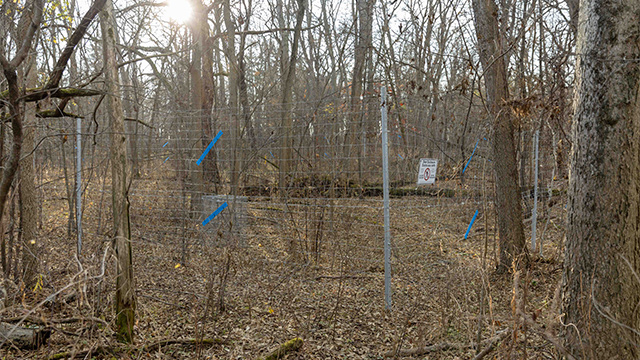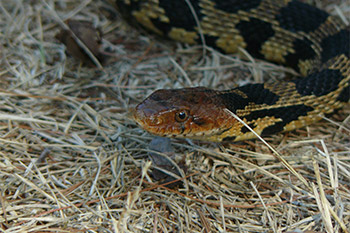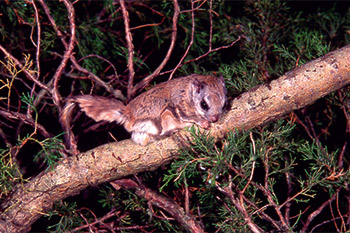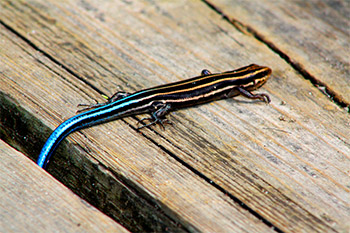
Research and monitoring
Point Pelee National Park
Vegetation monitoring and White-Tailed Deer

Point Pelee National Park conducts several different vegetation monitoring programs each year. Of these, two programs – seedling regeneration and browse monitoring – are a small part of the monitoring that supports the Hyperabundant Deer Management Program. The Hyperabundant Deer Management Program, in partnership with Caldwell First Nation, includes ecosystem monitoring, deer population monitoring, species-at-risk protection, and ongoing research and collaboration, in addition to reducing the deer population to sustainable levels to support ecosystem health.
Both seedling regeneration and deer browse monitoring focus on assessing smaller vegetation, which allows park staff to not only examine the current health of the forest, but also to predict forest health into the future.
Turtles

The marsh is Point Pelee’s largest habitat and is home to six different species of turtles, all of which are at risk. Habitat loss, predation and human impact are the major threats to turtles. To help turtles, we created a nest protection program, to reduce some of these threats.
During the month of June, a female turtle looks for sandy soil to lay her eggs. She digs a hole, lays and covers her eggs and then leaves the nest to return to the marsh. The nest is not protected by the adult, and is vulnerable to predation by animals like raccoons. To help protect the nests, Parks Canada staff place boxes made out of wood and wire to keep predators out, while still allowing warmth and moisture to reach the eggs, crucial to their development.
Prothonotary Warbler

This wee warbler can be found in Point Pelee’s swamp forest during the late spring and summer months. If you are not looking carefully though, you might miss it, as there are only two recorded mating pairs suspected to nest in the park. Despite being small in size, the Prothonotary warbler can be recognized by its bright yellow body, olive green back and grey wings and tail. It nests in naturally created cavities, such as the hollowed out trunks of dead trees, and tends to avoid settling in forests smaller than 100 acres. It finds protection by nesting over the standing waters of the swamp forest where its predators – like snakes and racoons – will have more trouble finding it.
In 2007, the Prothonotary warbler was accorded protection under the federal Species at Risk Act and Ontario’s Endangered Species Act, after a steady decline in the population over the previous 40 years. In 2008, just 10 pairs were recorded in all of Canada. Parks Canada is taking action to reduce some of the threats to the Prothonotary warbler and to encourage them to nest in the park.
Nesting options in Point Pelee National Park

The loss of breeding habitat caused by invasive insects and the draining of swamp forests across Ontario significantly impact this warbler’s ability to find suitable nesting spots. Point Pelee National Park has helped mitigate this threat by installing nesting cavities over standing water in the swamp forest to attract this species and increase nesting opportunities.
Nesting cavities are monitored by Resource Conservation staff three to four times a week during the breeding season to collect data on the number of Prothonotary warblers in the park and their nesting locations. This data helps Parks Canada and Bird Studies Canada understand the needs and threats to this species at risk.
This rare bird is one of the hundreds of bird species that visit the park each year. However, its population decline demonstrates how rapidly changes to the environment can affect the species that have called Point Pelee home for decades.
Best place to spot the Prothonotary Warbler:
Woodland Nature Trail
Eastern Foxsnake monitoring

The Eastern Foxsnake is a species at risk classified as threatened federally and endangered provincially. Research and monitoring on Eastern Foxsnakes has been taking place in the park for decades.
Flying Squirrels

The southern flying squirrel is one of the two species of flying squirrels found in North America. The southern flying squirrel is much smaller, has a white underbelly, and is more greyish in colour than its counterpart, the northern flying squirrel.
The southern flying squirrel is nocturnal - it sleeps in holes or tree cavities during the day and is active at night. Their large dark eyes assist with the squirrels’ night vision. At night, the southern flying squirrel gracefully glides from tree to tree using its gliding membrane or patagium, a fold of skin that extends from the wrist of the front leg to the ankle of the hind leg. Flying Squirrels are omnivores, their diet includes fruits, seeds, acorns and nuts, as well as insects, fungi, and birds’ eggs. Like most other squirrels, they love to collect and hoard piles of nuts and acorns for future use.
Bringing them back
Southern flying squirrels are native to this region and to Point Pelee National Park. However, due to a combination of human activities, the southern flying squirrel disappeared from the region and the park by the 1940s. Scientists believe they disappeared due to a loss of habitat, predation by domesticated cats, and the geographic isolation of the park.
Point Pelee has made great efforts to reintroduce the southern flying squirrel, and the protection and maintenance of the ecological integrity of its habitat has allowed its population to stabilize.
Over a two-year period in 1993 and 1994, working with researchers from the University of Guelph, the Friends of Point Pelee and Pelee Island Winery, Point Pelee National Park successfully reintroduced ninety-nine southern flying squirrels to the park. Continued monitoring of their health and population by park staff every other year will determine the survival of the gliders of the night.
Skink Monitoring

The Five-lined Skink is Ontario’s only native lizard and lives right here in Point Pelee. They are easy to identify –black with five creamy- yellow lines running down the length of their bodies.
While visiting Point Pelee, you may find a skink basking in the sun. Skinks are cold-blooded and rely on the warmth of the sun to warm themselves up.
When they are young they have bright blue tails. As skinks get older, their tails fade into a bronze colour. If males are ready to mate, they will have bright orange jaws and chins.
When skinks are being chased by a predator, they can actually separate their tail from their body. The separated tail can act as a distraction to the predator as the skink runs away. Five-lined skinks are able to grow back their tails, but only once! For this reason, it’s especially important not to pick up skinks you may find basking in the sun.
Skinks like to nest under logs that are moderately decayed, typically found in savannah habitat – where there is open space, sun and sandy soil. Females lay anywhere from two to fifteen eggs at a time. Each egg is about the size of a jellybean.
- Date modified :